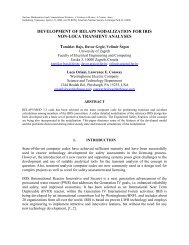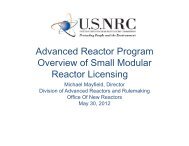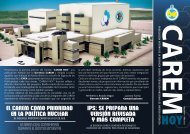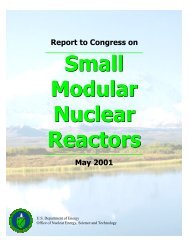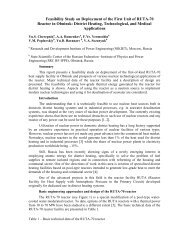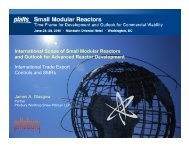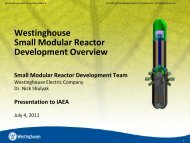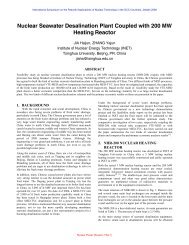SmAHTR – the Small Modular Advanced High Temperature Reactor
SmAHTR – the Small Modular Advanced High Temperature Reactor
SmAHTR – the Small Modular Advanced High Temperature Reactor
Create successful ePaper yourself
Turn your PDF publications into a flip-book with our unique Google optimized e-Paper software.
<strong>SmAHTR</strong> <strong>–</strong> <strong>the</strong> <strong>Small</strong><br />
<strong>Modular</strong> <strong>Advanced</strong> <strong>High</strong><br />
<strong>Temperature</strong> <strong>Reactor</strong><br />
Presented to<br />
DOE FHR Workshop<br />
Oak Ridge National Laboratory<br />
September 20-21, 2010<br />
By<br />
Sherrell Greene<br />
Director, Nuclear Technology Programs<br />
Oak Ridge National Laboratory<br />
greenesr@ornl.gov, 865.574.0626
2 Managed by UT-Battelle<br />
for <strong>the</strong> U.S. Department of Energy<br />
Presentation overview<br />
• <strong>SmAHTR</strong> design objectives<br />
• Preliminary <strong>SmAHTR</strong> concept<br />
• <strong>SmAHTR</strong> concept optimization and design trades<br />
• Principal <strong>SmAHTR</strong> development challenges<br />
<strong>SmAHTR</strong> development is a team effort:<br />
S. R. Greene J. C. Gehin D. E. Holcomb<br />
J. J. Carbajo D. Ilas V. K. Varma<br />
A. T. Cisneros* W. R. Corwin D. F. Wilson<br />
A. L. Qualls G. L. Yoder E. C. Bradley<br />
D. A. Clayton G. F. Flanagan M. S. Cetiner<br />
* UC<strong>–</strong>Berkeley<br />
S. R. Greene, 20 Sept 10
<strong>SmAHTR</strong> is <strong>the</strong> product of ORNL’s<br />
ongoing investigation of <strong>the</strong> FHR<br />
design space<br />
3 Managed by UT-Battelle<br />
for <strong>the</strong> U.S. Department of Energy<br />
• <strong>Reactor</strong> power level<br />
• Physical size<br />
• System complexity<br />
• Operating temperatures<br />
• Fuel forms<br />
• Material classes<br />
• Economics<br />
• Safety<br />
S. R. Greene, 20 Sept 10
<strong>SmAHTR</strong> design objectives target<br />
both electricity and process heat<br />
production<br />
• Initial concept operating temperature of 700 ºC with<br />
future evolution path to 850 ºC and 1000 ºC<br />
• Thermal size matched to early process heat markets<br />
• Integral system architectures compatible with remote<br />
operations<br />
• Passive decay heat removal<br />
• Truck transportable<br />
4 Managed by UT-Battelle<br />
for <strong>the</strong> U.S. Department of Energy<br />
S. R. Greene, 20 Sept 10
<strong>SmAHTR</strong> is an “entry-level” veryhigh-temperature<br />
reactor (VHTR)<br />
5 Managed by UT-Battelle<br />
for <strong>the</strong> U.S. Department of Energy<br />
Overall System Parameters<br />
Parameter Value<br />
Power (MWt / MWe) 125 / 50+<br />
Primary Coolant LiF-‐BeF 2<br />
Primary Pressure (atm) ~1<br />
Core Inlet <strong>Temperature</strong> (ºC) 650<br />
Core Outlet <strong>Temperature</strong> (ºC) 700<br />
Core coolant flow rate (kg/s) 1020<br />
OperaJonal Heat Removal 3 <strong>–</strong> 50% loops<br />
Passive Decay Heat Removal 3 <strong>–</strong> 50% loops<br />
Power Conversion Brayton<br />
<strong>Reactor</strong> Vessel PenetraJons None<br />
S. R. Greene, 20 Sept 10
<strong>SmAHTR</strong> is small…<br />
<strong>SmAHTR</strong><br />
<strong>Small</strong><br />
6 Managed by UT-Battelle<br />
for <strong>the</strong> U.S. Department of Energy<br />
AHTR<br />
Large<br />
S. R. Greene, 20 Sept 10
<strong>SmAHTR</strong> is a cartridge-core,<br />
integral-primary-system FHR<br />
Downcomer<br />
Skirt<br />
7 Managed by UT-Battelle<br />
for <strong>the</strong> U.S. Department of Energy<br />
(1 of 3) (1 of 3)<br />
S. R. Greene, 20 Sept 10
<strong>SmAHTR</strong> primary system mechanical<br />
design enables rapid component<br />
servicing<br />
IHX removal DRACS Core Removal Reflector<br />
removal<br />
Removal<br />
8 Managed by UT-Battelle<br />
for <strong>the</strong> U.S. Department of Energy<br />
Note: downcomer skirt not shown<br />
S. R. Greene, 20 Sept 10
Three fuel assembly concepts are under<br />
consideration (control rods not shown)<br />
2.2 cm dia. Solid<br />
cylindrical<br />
compact stringers<br />
9 Managed by UT-Battelle<br />
for <strong>the</strong> U.S. Department of Energy<br />
6 cm dia. Annular<br />
cylindrical compact<br />
stringers<br />
• Cylindrical fuel assembly O.D. = 34 cm<br />
• Plate fuel assembly O.D. = 43 cm<br />
23 cm wide Hex-plate<br />
fuel assemblies<br />
S. R. Greene, 20 Sept 10
Cylindrical annular compacts are current<br />
<strong>SmAHTR</strong> reference fuel concept<br />
<strong>SmAHTR</strong> Fuel / Core Parameter Op6on 1<br />
Fuel Assembly Design<br />
10 Managed by UT-Battelle<br />
for <strong>the</strong> U.S. Department of Energy<br />
Solid Cylindrical<br />
Compact Stringers<br />
in Hex Graphite<br />
Blocks<br />
Op6on 2<br />
(Reference) Op6on 3<br />
Annular Cylindrical<br />
Compact Stringers<br />
In Hex Graphite<br />
Blocks<br />
Flat Fuel Plates in<br />
Hex ConfiguraJon<br />
UCO fuel kernal diameter (microns) 425 500 500<br />
Number fuel columns or assemblies 19 19 19<br />
Number fuel pins / plates per column<br />
or fuel element<br />
Number graphite pins or plates per<br />
column or fuel element<br />
72 15 12<br />
19 4 9<br />
IniJal Fissile Mass (kg) 195 357 443<br />
Total Heavy Metal (kg) 987 1806 2240<br />
Enrichment 19.75% 19.75% 19.75%<br />
Avg. Power Density (MW/m 3 ) 9.4 9.4 9.4<br />
Refueling Interval (yr) 2.5 4.0 3.5<br />
S. R. Greene, 20 Sept 10
<strong>SmAHTR</strong> employs “two-out-of-three”<br />
heat transport design philosophy<br />
Intermediate Heat Transport Loop Parameters<br />
11 Managed by UT-Battelle<br />
for <strong>the</strong> U.S. Department of Energy<br />
Parameter Value<br />
Number of Primary Heat Exchangers (PHX) 3<br />
Number PHX needed for full power opera6on 2<br />
PHX Design Concept Single-‐pass, tube-‐in-‐shell<br />
Primary Coolant LiF-‐BeF 2<br />
Primary Inlet <strong>Temperature</strong> (ºC) 700<br />
Primary Outlet <strong>Temperature</strong> (ºC) 650<br />
Primary flow rate (kg/s) 350 (each)<br />
Secondary Coolant LiF-‐NaF-‐KF<br />
Secondary Inlet <strong>Temperature</strong> (ºC) 582<br />
Primary Outlet <strong>Temperature</strong> (ºC) 610<br />
Secondary flow rate (kg/s) 800 (each)<br />
S. R. Greene, 20 Sept 10
<strong>SmAHTR</strong> employs “two-out-of-three”<br />
passive decay heat removal<br />
In-vessel Passive Decay Heat Removal System Parameters<br />
12 Managed by UT-Battelle<br />
for <strong>the</strong> U.S. Department of Energy<br />
In-‐vessel DRACS HX Parameter Value<br />
Number DRACS in-‐vessel heat exchangers 3<br />
Number DRACS loops needed for full<br />
power opera6on<br />
DRACS Salt-‐to-‐Salt Design Concept Single-‐pass, tube-‐in-‐shell<br />
Primary Coolant LiF-‐BeF 2<br />
Secondary Coolant LiF-‐NaF-‐KF<br />
2<br />
S. R. Greene, 20 Sept 10
<strong>SmAHTR</strong> DRACS utilizes salt-to-air,<br />
natural convection heat rejection<br />
Ex-vessel Passive Decay Heat Removal System Parameters<br />
FLiNaK<br />
Invessel<br />
DRACS<br />
HX<br />
~<br />
FLiBe<br />
13 Managed by UT-Battelle<br />
for <strong>the</strong> U.S. Department of Energy<br />
Salt-to-<br />
Air<br />
Radiator<br />
Air<br />
Ex-‐vessel DRACS HX Parameter Value<br />
Number DRACS 3<br />
Number DRACS needed for full power<br />
opera6ons<br />
DRACS Salt-‐to-‐Air Design Concept Ver6cal finned tube radiator<br />
Primary Coolant LiF-‐NaF-‐KF<br />
Air Flow Area (m 2 ) 4<br />
In-‐vessel HX <strong>–</strong> to <strong>–</strong> air HX riser height (m) 8<br />
Total chimney height (m) 12<br />
2<br />
S. R. Greene, 20 Sept 10
<strong>SmAHTR</strong> is good match with Brayton<br />
power conversion technologies<br />
• Options<br />
<strong>–</strong> Standard closed<br />
<strong>–</strong> Supercritical closed<br />
<strong>–</strong> Open air (similar to ANP & HTRE)<br />
• Issues to consider<br />
<strong>–</strong> Physical size & weight<br />
<strong>–</strong> Multi-unit clustering<br />
<strong>–</strong> Heat exchanger pressure differentials<br />
<strong>–</strong> Efficiency and scalability to higher temperatures<br />
<strong>–</strong> Tritium leakage<br />
<strong>–</strong> Compatibility with dry heat rejection<br />
• Trade study underway<br />
14 Managed by UT-Battelle<br />
for <strong>the</strong> U.S. Department of Energy<br />
S. R. Greene, 20 Sept 10
<strong>SmAHTR</strong> <strong>the</strong>rmal energy storage<br />
system employs “salt vault” <strong>the</strong>rmal<br />
storage concept<br />
• Liquid salt vault acts as<br />
<strong>the</strong>rmal battery<br />
• Salt vault enables<br />
clustering of reactors<br />
• Salt selection and salt vault<br />
size can be optimized for<br />
differing applications<br />
<strong>–</strong> 125 MWt-hr storage @ 600ºC<br />
requires ~ 13 meter cubic<br />
salt tank<br />
15 Managed by UT-Battelle<br />
for <strong>the</strong> U.S. Department of Energy<br />
S. R. Greene, 20 Sept 10
Peak center-line fuel temperatures during<br />
normal operations are acceptable<br />
650°C<br />
16 Managed by UT-Battelle<br />
for <strong>the</strong> U.S. Department of Energy<br />
1178°C<br />
700°C<br />
S. R. Greene, 20 Sept 10
Peak fuel temperatures for Alpha<br />
Transient (20 s pump coast-down with<br />
10 s scram delay) only increase ~50 ºC<br />
17 Managed by UT-Battelle<br />
for <strong>the</strong> U.S. Department of Energy<br />
S. R. Greene, 20 Sept 10
Two DRACS loops limit coolant<br />
temperature rise to less than 30ºC<br />
18 Managed by UT-Battelle<br />
for <strong>the</strong> U.S. Department of Energy<br />
727°C<br />
712°C<br />
S. R. Greene, 20 Sept 10
A <strong>SmAHTR</strong> materials technology<br />
evolution strategy is in development<br />
System Element @ 700 ºC @ 850 ºC @ 1000 ºC<br />
Graphite Internals Toyo Tanso IG110 or 430 Toyo Tanso IG110 or 430 Toyo Tanso IG110 or 430<br />
<strong>Reactor</strong> Vessel Hastelloy-N • Ni-weld overlay on 800H<br />
• Insulated low-alloy steel<br />
• New Ni-based alloy<br />
Core barrel &<br />
o<strong>the</strong>r internals<br />
Control rods and<br />
internal drives<br />
19 Managed by UT-Battelle<br />
for <strong>the</strong> U.S. Department of Energy<br />
Hastelloy-N • C-C composite<br />
• New Ni-based alloy<br />
• C-C composites<br />
• Hastelloy-N<br />
• Nb-1Zr<br />
• C-C composites<br />
• Nb-1Zr<br />
PHX & DRACS Hastelloy-N • New Ni-based alloy<br />
• Double-sided Ni cladding<br />
on 617 or 230<br />
Secondary (saltto-gas)<br />
HX<br />
Coaxial extruded 800H<br />
tubes with Ni-based<br />
layer<br />
• New Ni-based alloy<br />
• Coaxial extruded 800H<br />
tubes with Ni-based layer<br />
• Interior-insulated lowalloy<br />
steel<br />
• C-C composite<br />
• SiC-SiC composite<br />
• New refractory metal<br />
• C-C composites<br />
• Nb-1Zr<br />
• C-C composite<br />
• SiC-SiC composite<br />
• Monolithic SiC<br />
?<br />
S. R. Greene, 20 Sept 10
20 Managed by UT-Battelle<br />
for <strong>the</strong> U.S. Department of Energy<br />
Summary<br />
• <strong>SmAHTR</strong> is an “entry-level” VHTR concept<br />
• <strong>SmAHTR</strong> concept explores <strong>the</strong> small FHR design space<br />
• <strong>SmAHTR</strong> concept is not optimized<br />
<strong>–</strong> Many design trades still to be evaluated<br />
• <strong>SmAHTR</strong> design objectives:<br />
<strong>–</strong> address near-term process heat and electricity applications<br />
<strong>–</strong> enable long-term evolution to higher efficiency electric<br />
generation and higher temperature process heat applications<br />
• <strong>SmAHTR</strong> integrates architectures and technologies of<br />
MSR, GCR, LMR, and integral LWR systems<br />
S. R. Greene, 20 Sept 10



